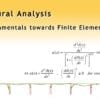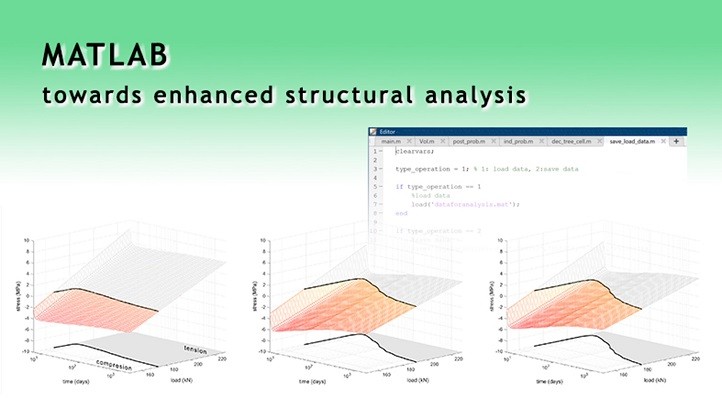MATLAB towards enhanced structural analysis
50 hours / 6 weeks |
|
Online course |
|
To be determined |
Introduction
Nowadays, programming is already an essential skill in the field of Engineering and for those pursuing a profile as a recognized expert in the field of structural analysis is already mandatory. For this fact, the technology evolution, mainly since the last quarter of the XX century, has been working as a catalyser in the inclusion of programming skills in Engineering degrees.
Among the available and most used programming languages in Engineering, MATLAB (an abbreviation of MAtrix LABoratory) distinguishes by its wide utilization in the academia in both teaching and research. Its ability to (i) perform complex matrix calculations, (ii) plot data in several layout formats (1D, 2D, and 3D), (iii) create user-interfaces with very appealing and professional layouts, and (iv) implement algorithms based on a high-level programming language, including the possibility on interfacing with programs written in other languages, makes MATLAB a very useful and easy to learn software package. As examples, MATLAB is widely used by researchers and practitioners in deep/machine learning, signal processing, and communications, image and video processing, control systems, test and measurement, computational finance, and computational biology. In education, it is particularly used to teach linear algebra and numerical analysis, which are core disciplines in the field of structural analysis.
In this context, this course is ideal for those aiming to gain skills in using MATLAB functionalities to solve problems in the field of structural engineering (but not limited). More precisely, and for instance, the displacement time-series of a single/multi-degree of freedom system, the internal forces in a complex multi-span system and identification of critical sections (i.e. maximum internal forces), cross-section optimization of beams under non-uniform loading schemes, probability of failure of structural components when subjected to uncertainties.
Objectives
In this context, the course objectives can be organized as follows (bottom-up):
- To understand the MATLAB environment and its workflow,
- To learn how to declare variables and use them further,
- To import data from external sources,
- To operate with loops and recursion,
- To master matrices and vectors,
- To create functions and explore it further,
- To set scripts as a sequence of MATLAB commands/functions,
- To solve problems by means of dedicated scripts,
- To draw the desired results by means of the graphical features of MATLAB.
It is worth to highlight that learning to program in MATLAB will offer already useful skills for other programming languages (e.g. loops, recursive, matrices, vectors). The course does not include the license for MATLAB and Simulink Student Suite software.
The course content is mainly based on practical applications, i.e. by (i) formulating problems, (ii) setting suitable algorithms, and (iii) coding it in MATLAB, and (iv) presenting the outputs in an informative and appealing layout. This will allow strengthening the student’s skills in the effective utilization of the MATLAB features and prepare them to be able to tackle advanced/complex structural engineering problems in their professional life.
In a bottom-up approach, the course is set in six modules, starting from the basic concepts towards the aimed problem-solving skills by using MATLAB:
- – Module 1 – Introduction:
- Brief history,
- The environment and its workflow.
- – Module 2 – Fundamental concepts:
- Declare variables and operate with them,
- Working with vectors and matrices,
- Built-in functions,
- Practical exercise 1.
- -Module 3 – Conditional statements and loops:
- If statement,
- Switch statement,
- Try/catch statement,
- For loop,
- While loop,
- Nested loops,
- Practical exercise 2.
- – Module 4 – Start building programs in MATLAB:
- User-defined functions,
- Script files as a sequence of commands,
- Exploiting the built-in and user-defined functions in scripts,
- Practical exercise 3.
- – Module 5 – Enhance programs with input/output data functionalities:
- Request user input in the command line,
- Input files with extension .txt and .xls,
- Output data on the command line,
- Output files with extension .txt and .mat,
- Practical exercise 4.
- – Module 6 – Extract useful information from data through suitable graphical outputs:
- 2D graphics,
- 3D graphics,
- Exploring data graphically,
- Layout improvements,
- Practical exercise 5.
The learning method used along the course is based on online resources, available by the virtual Campus, with a clear and straightforward approach. For this, the planned 6 modules (described above), will be based on comprehensive documentation covering the MATLAB features as well as practical exercises to be solved by the students. Hence, the course will be materialized by:
- – Lecture notes and complementary documentation with the theory,
- – Recorded lectures explaining the content on the lecture notes,
- – Exercises to apply and consolidate the theory,
- – Live classes, through videoconferences (webinars), for clarification on the exercises,
Tutorial support along all course period by email to enhance students’ progress.
Helder Sousa
Dr Helder Sousa is an expert, with 17 years of international experience and strong exposure to the industry sector, on Structural Health Monitoring (SHM) applied on Civil Engineering infrastructures and Visiting Professor at the University of Surrey, UK.
With core expertise in Civil Engineering (PhD, 2012, http://repositorio-aberto.up.pt/handle/10216/68424), his scientific knowledge spans from (before PhD conclusion) advanced Finite Element Analysis of full-scale structures to (after PhD conclusion) Bayesian statistics and Value of Information theory, mainly single and sequential updating methods, passing through wide experience in tacking big-data streams collected by monitoring systems installed on full-scale bridges. Altogether makes Dr Sousa holding a holistic and singular profile with a comprehensive view and perception on the different levels of science, i.e. fundamental research and applied research.
With 42 conference papers, 15 scientific journal papers, 2 book chapters, more than 35 oral presentations in several countries of Europe and beyond, as well as 4 short-scientific missions at top leading R&D Institutes in Europe (ETH Zurich in Switzerland, TNO R&D institute in Netherlands, CEREMA in France and COWI in Denmark), makes Dr Sousa has one of the leading researchers in his research field.
Awarded with several research grants and consultancy funding, highlighting his Individual Marie Skłodowska-Curie Fellowship (2015-17, http://www.lostprecon.eu/) and his recent role as the leader of the Innovation Committee of the European COST Action TU1402 – Quantifying the Value of Structural Health Monitoring, as a legal representative of the BRISA Group (2014-19, http://www.cost-tu1402.eu/Action/Innovation-Committee). Currently, he is Guest Editor in the top-ranked scientific journal Structure & Infrastructure Engineering and (co-)leads two special sessions in the next European Workshop on Structural Health Monitoring (Italy, 2020) and in the 13th ASCE Specialty Conference on Probabilistic Mechanics and Reliability (New York, 2020). His enrolment in scientific committees at the European level and wide experience in acting as a reviewer for national and international science councils is also a clear demonstration of his leadership and independence skills.
In the context of this course, the following publications on international top-scientific journals in the field of Civil Engineering might be of relevance for interested people:
- – Sousa, H. (2020) “Advanced FE modelling supported by monitoring towards management of large civil infrastructures – The case study of Lezíria Bridge.” Structural Concrete, the official journal of the fib (accepted for publication, 18th March 2020).
- – Sousa, H., A. Rozsas, A. Slobbe and W. Courage (2020). “A novel pro-active approach towards SHM-based bridge management supported by FE analysis and Bayesian methods.” Structure and Infrastructure Engineering 16(2): 233-246. (http://doi.org/10.1080/15732479.2019.1649287)
- – Sousa, H., L. O. Santos and M. Chryssanthopoulos (2019). “Quantifying monitoring requirements for predicting creep deformations through Bayesian updating methods.” Structural Safety 76: 40-50. (http://doi.org/10.1016/j.strusafe.2018.06.002)
- – Sousa, H., B. J. A. Costa, A. A. Henriques, J. Bento and J. A. Figueiras (2016). “Assessment of traffic load events and structural effects on road bridges based on strain measurements.” Journal of Civil Engineering and Management 22(4): 457-469. (http://doi.org/10.3846/13923730.2014.897991)
- – Sousa, H., J. Bento and J. Figueiras (2014). “Assessment and Management of Concrete Bridges Supported by Monitoring Data-Based Finite-Element Modeling.” Journal of Bridge Engineering 19(6): 05014002. (http://doi.org/10.1061/(ASCE)BE.1943-5592.0000604)
All of our courses are offered 100% online, through our intuitive Virtual Campus. Topics are taught through:
- – Videos
- – Interactive multimedia content
- – Live classes
- – Texts
- – Case studies
- – Evaluation exercises
- – Additional documentation
The content is updated in each new course edition, so that knowledge is acquired around the latest news and state-of-the-art geotechnical engineering technology.
One of the most interesting aspects of our courses is the use of live videoconferences, in which teachers and students interact in a continuous exchange of knowledge and problem solving. In addition to this, students can make use of the platform’s forum, a meeting point where they can interact with teachers and other students.
A tutoring system will also be established by email, which will resolve any possible doubts about the course, and which will serve as a point of connection for students with specific questions on each module.
Students can also download all course documentation, including texts, videos, video conferences and exercises.
The course MATLAB towards enhanced structural analysis is a practical-based and problem-solving oriented course, structured on a bottom-up approach meaning that no special knowledge is required in the subject. Hence, this course might be of interest to (but not limited, of course):
- – Graduated engineers/technicians with interest in getting into the subject to towards a postgraduate course in structural engineering,
- – Postgraduate engineers/architects with interest to review concepts and improve skills in programming to enhance their ability in solving challenging/complex problems in their professional life,
- – Researchers aiming for deep learning on advanced structural analysis with the support of MATLAB or other programming languages.
At the end of the course, and as accreditation of knowledge acquired and of the technical and practical training, students who correctly complete the corresponding evaluation tests of the geotechnical engineering course will obtain an academic certificate issued by Ingeoexpert. This digital certificate is protected by Blockchain technology, making it unique and tamper-proof, thus enabling companies to verify its authenticity.
It can also be downloaded by students, forwarded by email and shared on social networks, as well as embedded on any website. You can see an example here.
Programming skills are nowadays of paramount importance in the context of problem-solving in the field of structural engineering. Indeed, it is envisaged that in the XXI century, the structural problems become more and more complex and those with robust skills, including programming, will be at the forefront in the job market. Taking into account the comprehensive approach of this course, the following job prospects are envisaged, mainly:
- – Expert for design and construction offices in Civil Engineering and Architecture,
- – Consultant for owners of structures, insurance companies, professional associations, among others,
- – Leading structural engineer towards problem-solving thinking with the support of programming skills.
Introduction
Nowadays, programming is already an essential skill in the field of Engineering and for those pursuing a profile as a recognized expert in the field of structural analysis is already mandatory. For this fact, the technology evolution, mainly since the last quarter of the XX century, has been working as a catalyser in the inclusion of programming skills in Engineering degrees.
Among the available and most used programming languages in Engineering, MATLAB (an abbreviation of MAtrix LABoratory) distinguishes by its wide utilization in the academia in both teaching and research. Its ability to (i) perform complex matrix calculations, (ii) plot data in several layout formats (1D, 2D, and 3D), (iii) create user-interfaces with very appealing and professional layouts, and (iv) implement algorithms based on a high-level programming language, including the possibility on interfacing with programs written in other languages, makes MATLAB a very useful and easy to learn software package. As examples, MATLAB is widely used by researchers and practitioners in deep/machine learning, signal processing, and communications, image and video processing, control systems, test and measurement, computational finance, and computational biology. In education, it is particularly used to teach linear algebra and numerical analysis, which are core disciplines in the field of structural analysis.
In this context, this course is ideal for those aiming to gain skills in using MATLAB functionalities to solve problems in the field of structural engineering (but not limited). More precisely, and for instance, the displacement time-series of a single/multi-degree of freedom system, the internal forces in a complex multi-span system and identification of critical sections (i.e. maximum internal forces), cross-section optimization of beams under non-uniform loading schemes, probability of failure of structural components when subjected to uncertainties.
Objectives
In this context, the course objectives can be organized as follows (bottom-up):
- To understand the MATLAB environment and its workflow,
- To learn how to declare variables and use them further,
- To import data from external sources,
- To operate with loops and recursion,
- To master matrices and vectors,
- To create functions and explore it further,
- To set scripts as a sequence of MATLAB commands/functions,
- To solve problems by means of dedicated scripts,
- To draw the desired results by means of the graphical features of MATLAB.
It is worth to highlight that learning to program in MATLAB will offer already useful skills for other programming languages (e.g. loops, recursive, matrices, vectors). The course does not include the license for MATLAB and Simulink Student Suite software.
The course content is mainly based on practical applications, i.e. by (i) formulating problems, (ii) setting suitable algorithms, and (iii) coding it in MATLAB, and (iv) presenting the outputs in an informative and appealing layout. This will allow strengthening the student’s skills in the effective utilization of the MATLAB features and prepare them to be able to tackle advanced/complex structural engineering problems in their professional life.
In a bottom-up approach, the course is set in six modules, starting from the basic concepts towards the aimed problem-solving skills by using MATLAB:
- – Module 1 – Introduction:
- Brief history,
- The environment and its workflow.
- – Module 2 – Fundamental concepts:
- Declare variables and operate with them,
- Working with vectors and matrices,
- Built-in functions,
- Practical exercise 1.
- -Module 3 – Conditional statements and loops:
- If statement,
- Switch statement,
- Try/catch statement,
- For loop,
- While loop,
- Nested loops,
- Practical exercise 2.
- – Module 4 – Start building programs in MATLAB:
- User-defined functions,
- Script files as a sequence of commands,
- Exploiting the built-in and user-defined functions in scripts,
- Practical exercise 3.
- – Module 5 – Enhance programs with input/output data functionalities:
- Request user input in the command line,
- Input files with extension .txt and .xls,
- Output data on the command line,
- Output files with extension .txt and .mat,
- Practical exercise 4.
- – Module 6 – Extract useful information from data through suitable graphical outputs:
- 2D graphics,
- 3D graphics,
- Exploring data graphically,
- Layout improvements,
- Practical exercise 5.
The learning method used along the course is based on online resources, available by the virtual Campus, with a clear and straightforward approach. For this, the planned 6 modules (described above), will be based on comprehensive documentation covering the MATLAB features as well as practical exercises to be solved by the students. Hence, the course will be materialized by:
- – Lecture notes and complementary documentation with the theory,
- – Recorded lectures explaining the content on the lecture notes,
- – Exercises to apply and consolidate the theory,
- – Live classes, through videoconferences (webinars), for clarification on the exercises,
Tutorial support along all course period by email to enhance students’ progress.
Helder Sousa
Dr Helder Sousa is an expert, with 17 years of international experience and strong exposure to the industry sector, on Structural Health Monitoring (SHM) applied on Civil Engineering infrastructures and Visiting Professor at the University of Surrey, UK.
With core expertise in Civil Engineering (PhD, 2012, http://repositorio-aberto.up.pt/handle/10216/68424), his scientific knowledge spans from (before PhD conclusion) advanced Finite Element Analysis of full-scale structures to (after PhD conclusion) Bayesian statistics and Value of Information theory, mainly single and sequential updating methods, passing through wide experience in tacking big-data streams collected by monitoring systems installed on full-scale bridges. Altogether makes Dr Sousa holding a holistic and singular profile with a comprehensive view and perception on the different levels of science, i.e. fundamental research and applied research.
With 42 conference papers, 15 scientific journal papers, 2 book chapters, more than 35 oral presentations in several countries of Europe and beyond, as well as 4 short-scientific missions at top leading R&D Institutes in Europe (ETH Zurich in Switzerland, TNO R&D institute in Netherlands, CEREMA in France and COWI in Denmark), makes Dr Sousa has one of the leading researchers in his research field.
Awarded with several research grants and consultancy funding, highlighting his Individual Marie Skłodowska-Curie Fellowship (2015-17, http://www.lostprecon.eu/) and his recent role as the leader of the Innovation Committee of the European COST Action TU1402 – Quantifying the Value of Structural Health Monitoring, as a legal representative of the BRISA Group (2014-19, http://www.cost-tu1402.eu/Action/Innovation-Committee). Currently, he is Guest Editor in the top-ranked scientific journal Structure & Infrastructure Engineering and (co-)leads two special sessions in the next European Workshop on Structural Health Monitoring (Italy, 2020) and in the 13th ASCE Specialty Conference on Probabilistic Mechanics and Reliability (New York, 2020). His enrolment in scientific committees at the European level and wide experience in acting as a reviewer for national and international science councils is also a clear demonstration of his leadership and independence skills.
In the context of this course, the following publications on international top-scientific journals in the field of Civil Engineering might be of relevance for interested people:
- – Sousa, H. (2020) “Advanced FE modelling supported by monitoring towards management of large civil infrastructures – The case study of Lezíria Bridge.” Structural Concrete, the official journal of the fib (accepted for publication, 18th March 2020).
- – Sousa, H., A. Rozsas, A. Slobbe and W. Courage (2020). “A novel pro-active approach towards SHM-based bridge management supported by FE analysis and Bayesian methods.” Structure and Infrastructure Engineering 16(2): 233-246. (http://doi.org/10.1080/15732479.2019.1649287)
- – Sousa, H., L. O. Santos and M. Chryssanthopoulos (2019). “Quantifying monitoring requirements for predicting creep deformations through Bayesian updating methods.” Structural Safety 76: 40-50. (http://doi.org/10.1016/j.strusafe.2018.06.002)
- – Sousa, H., B. J. A. Costa, A. A. Henriques, J. Bento and J. A. Figueiras (2016). “Assessment of traffic load events and structural effects on road bridges based on strain measurements.” Journal of Civil Engineering and Management 22(4): 457-469. (http://doi.org/10.3846/13923730.2014.897991)
- – Sousa, H., J. Bento and J. Figueiras (2014). “Assessment and Management of Concrete Bridges Supported by Monitoring Data-Based Finite-Element Modeling.” Journal of Bridge Engineering 19(6): 05014002. (http://doi.org/10.1061/(ASCE)BE.1943-5592.0000604)
All of our courses are offered 100% online, through our intuitive Virtual Campus. Topics are taught through:
- – Videos
- – Interactive multimedia content
- – Live classes
- – Texts
- – Case studies
- – Evaluation exercises
- – Additional documentation
The content is updated in each new course edition, so that knowledge is acquired around the latest news and state-of-the-art geotechnical engineering technology.
One of the most interesting aspects of our courses is the use of live videoconferences, in which teachers and students interact in a continuous exchange of knowledge and problem solving. In addition to this, students can make use of the platform’s forum, a meeting point where they can interact with teachers and other students.
A tutoring system will also be established by email, which will resolve any possible doubts about the course, and which will serve as a point of connection for students with specific questions on each module.
Students can also download all course documentation, including texts, videos, video conferences and exercises.
The course MATLAB towards enhanced structural analysis is a practical-based and problem-solving oriented course, structured on a bottom-up approach meaning that no special knowledge is required in the subject. Hence, this course might be of interest to (but not limited, of course):
- – Graduated engineers/technicians with interest in getting into the subject to towards a postgraduate course in structural engineering,
- – Postgraduate engineers/architects with interest to review concepts and improve skills in programming to enhance their ability in solving challenging/complex problems in their professional life,
- – Researchers aiming for deep learning on advanced structural analysis with the support of MATLAB or other programming languages.
At the end of the course, and as accreditation of knowledge acquired and of the technical and practical training, students who correctly complete the corresponding evaluation tests of the geotechnical engineering course will obtain an academic certificate issued by Ingeoexpert. This digital certificate is protected by Blockchain technology, making it unique and tamper-proof, thus enabling companies to verify its authenticity.
It can also be downloaded by students, forwarded by email and shared on social networks, as well as embedded on any website. You can see an example here.
Programming skills are nowadays of paramount importance in the context of problem-solving in the field of structural engineering. Indeed, it is envisaged that in the XXI century, the structural problems become more and more complex and those with robust skills, including programming, will be at the forefront in the job market. Taking into account the comprehensive approach of this course, the following job prospects are envisaged, mainly:
- – Expert for design and construction offices in Civil Engineering and Architecture,
- – Consultant for owners of structures, insurance companies, professional associations, among others,
- – Leading structural engineer towards problem-solving thinking with the support of programming skills.
2 reviews for MATLAB towards enhanced structural analysis
More info
Finish this course and get a certificate based on Blockchain
MATLAB towards enhanced structural analysis

Blockchain technology makes the certificate incorruptible, enabling companies to verifiy its autenticity.





Walid Hendaoui –
This course is a very good introduction to the fundamentals of programming in MATLAB and its applications in structural analysis. Dr Sousa provides his precious help throughout the course and it’s very instructive for the students.
Rocco Manzi –
During the past five weeks, I had the pleasure of taking an outstanding course. The civil engineering topics were fascinating and Dr. Sousa’s support was incredibly helpful. Additionally, Dr. Sousa is a very kind person and the IngeOxpert platform is excellently designed. Each lecture provided me with numerous hints and clues that aided me in solving all the weekly exercises step by step. I highly recommend this course to anyone seeking to gain new knowledge on Matlab and Programming, as it provides a solid foundation for further and more extensive learning.